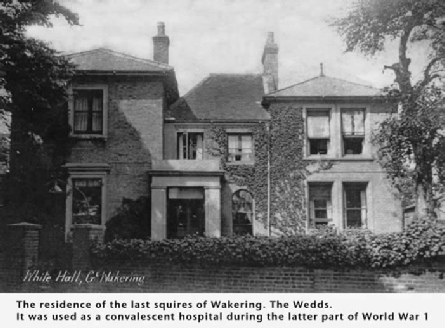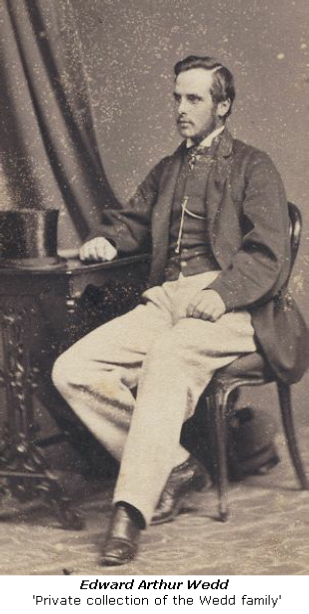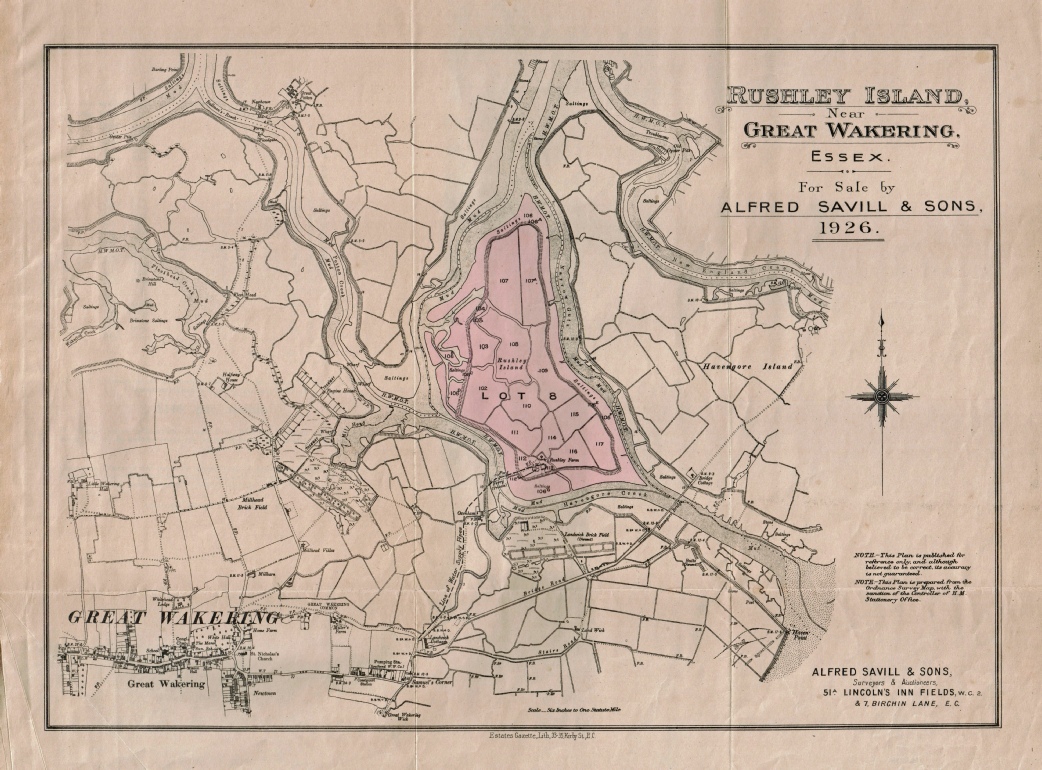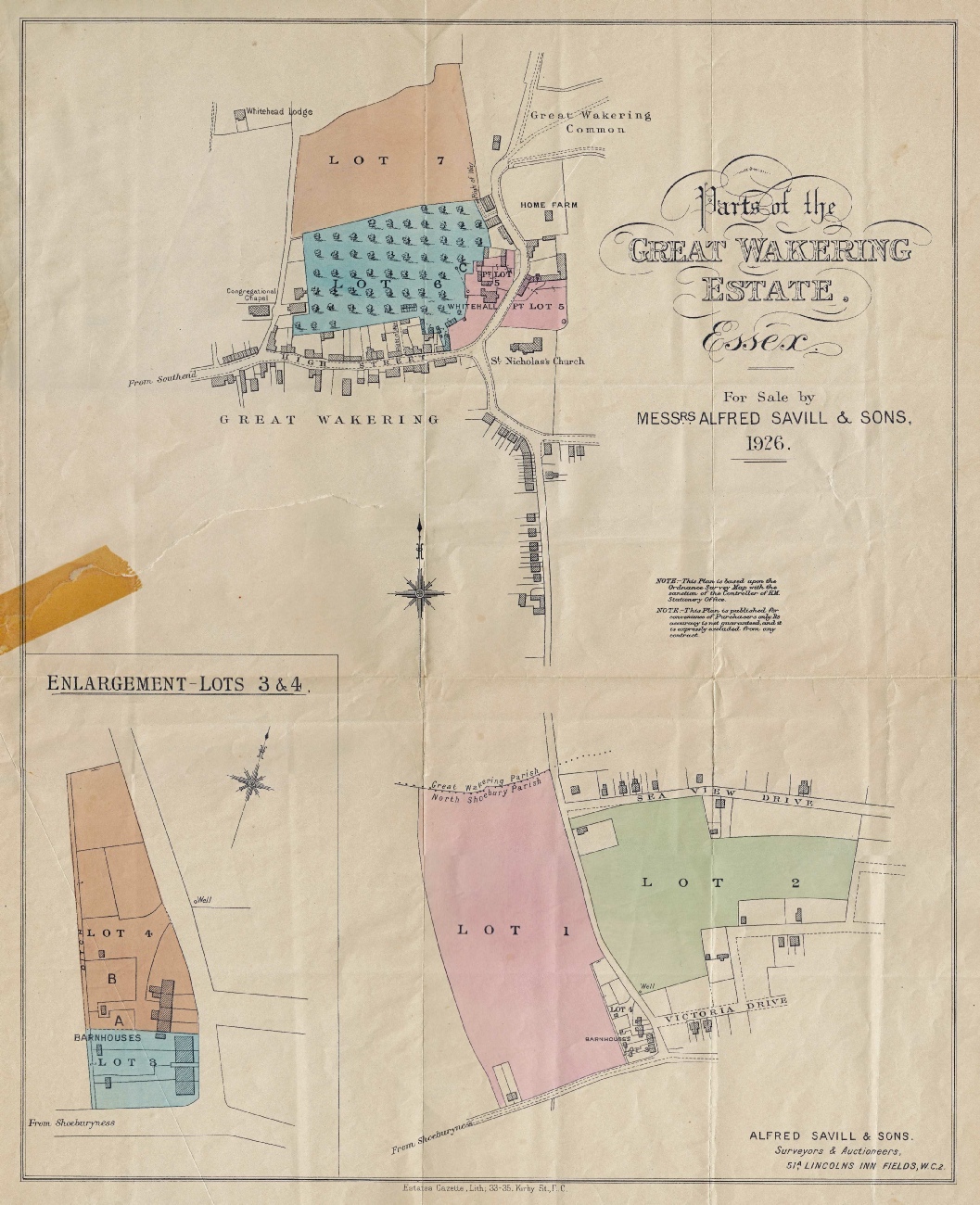Portions of the Great Wakeri![Portions_of_the_Great_Wakering_Estate_Essex_in_1926_[No Maps].pdf](wpimages/wpbb0b1627_05_06.jpg) ng Estate which were owned by the Wedd family were sold in 1954, the year after the disastrous floods. It is understood that the sale was necessary in order to meet Estate Duty liability. The lands, almost in their entirety, were purchased by Mr Bentall. The Whitehall residence itself was demolished in 1971 and a modern housing estate which was built in the grounds has taken the name 'Whitehall Estate'.
ng Estate which were owned by the Wedd family were sold in 1954, the year after the disastrous floods. It is understood that the sale was necessary in order to meet Estate Duty liability. The lands, almost in their entirety, were purchased by Mr Bentall. The Whitehall residence itself was demolished in 1971 and a modern housing estate which was built in the grounds has taken the name 'Whitehall Estate'.
In October, Dave Lee was presented by Rita Stow with an old estate agent's document which came from the Stow family attic. The original document, which is 90 years old relates to the sale of ‘Portions of the Great Wakering Estate Essex in 1926’.
The document is in a fragile condition and relates to the late Village Squire of Great Wakering, Mr Edward Arthur Wedd who died in 1925. He was a popular local farmer who owned a lot of land and property in Great Wakering. As the owner of this document, Rita asked us to find a good home for it and Dave immediately set about scanning it in, whilst noting the following interesting facts:
The estate agent had to delay the arranged auction sale date by 2 weeks because of the 1926 General Strike (see red coloured label stuck on the front cover of the document}.
Lot 5 gives a detailed description of 'Whitehall' the big impressive house which he remembered as a child located opposite St Nicholas Church before it was demolished to make way for the Whitehall Estate.
It mentions many old Wakering family names in the different property leases.
The full document excluding the maps can be viewed by left-clicking on the Cover Image (left). The maps, which show the various lot details, can be viewed further down the page.
Landowners of Great Wakering in 1841
According to the 1841 Tithe Apportionment, there were over 20 landowners in the parish Great Wakering, excluding house and shop property and their adjacent land. Apart from the fields and marshes east of the village, the ownership was fairly well spread.
- By far the largest landowner was the Wedd family, their land stretching from their Whitehall estate and Hill barn to Oxenham, to Landwick and beyond to the coast and to Wakering Stairs. The brickfields at Mill Head and Landwick were also included.
- Rebecca Pinnock and Ephraim Howard owned a stretch of land beyond the Wick. It included arable, pasture and saltings and together with the Wick homestead, was occupied by Wither Jennings.
- Francis Bannister owned and occupied Rushley Island.
- Samuel Benton owned and farmed extensive land around Oldbury.
- Richard Catlow Bowden owned the land between Oxenham and the creek, together with scattered fields elsewhere and also Millers Farm, all of which was farmed by Thomas Rumball.
- Thomas Bannister Castle owned land across from Clay Street, all occupied by Christopher Parsons. He also owned Winters, occupied by John Gladwin.
- Joseph Shinglewood Crosin was the proprietor of land south of the High Street, including what is now called Lion Field.
- Sir John Ryssen Tyrell owned a stretch of land south of Little Wakering Hall and land south of the High Street, opposite Little Wakering Corner. All were farmed by Charles Asplin.
- Lord Henniker owned Great Potten Island, which was let to Joseph Hickenbotham.
Wedd Family History
Extract from ‘The Rayner Family of Great Wakering” by Albert Rayner Bsc (Econ) FCA [page 64]
 According to the Tithe Apportionment of 1841, Alfred Wedd (1789-1877) was farming all the land which was owned by the Wedd family. In due course he was farming some 600 acres and employing some 30 men, including a farm bailiff. He was a bachelor and, in fact, was recognised as the Village Squire.
According to the Tithe Apportionment of 1841, Alfred Wedd (1789-1877) was farming all the land which was owned by the Wedd family. In due course he was farming some 600 acres and employing some 30 men, including a farm bailiff. He was a bachelor and, in fact, was recognised as the Village Squire.
The Wedd family were important farmers and land owners in the village of Fowlmere in Cambridgeshire. The attachment of certain members of the family to Great Wakering arose as a result of marriage on 1 March 1780 at All Saints Church in Maldon, Essex, between William Wedd (1755-1819) and Elizabeth Wallman Pattisson (1758-1845). Elizabeth was the eldest child of Joseph Pattisson senior of Maldon and grandchild of William Wallman of Thorpe Hal 1, Southchurch, Essex. Some of the Pattisson family lived in Wakering and according to an Electoral Roll of 1832 there was a James Pattisson living at Trotters Farm. They were staunch Congregational i sts and in 1822 one member of the family gave half an acre of land to Trustees for the building of a Dissenters Chapel. The Wedds, when they settled in Great Wakering, supported the village Congregational Church.
A most comprehensive Wedd family tree, prepared by Mrs Gwen Rawlingson of Great Wakering, shows that the Wedd family descend from Peter Wedd of Royston in Hertfordshire, who purchased land in Fowlmere in 1668. As a result of the marriage on 15 June 1705, of his grandson, Benjamin Wedd of Fowlmere to Hester Crackenthorpe, only daughter of the Reverend John Crackenthorpe, Rector of Fowlmere…
The aforementioned Alfred Wedd was the eighth surviving child of William and Elizabeth Wallman Wedd. According to the Tithe Apportionment made in 1841 Alfred Wedd occupied 114 acres of land owned by his mother, Elizabeth Wallman Wedd, which area included the Mi 11 head brickworks. Alfred also occupied a further 407 acres, the owners being recorded as Admiral Jacob Henniker-Major and Alfred Wedd, this area including the brickworks north of Landwick.
Alfred owned and occupied the Whitehall Estate, comprising the house known as 'Whitehall', an area of woodland, an orchard and 7 acres of arable land. He also occupied the Rectorial Glebe, being 58 acres owned by Thomas Clough, situated around the church and including Home Farm then known as Rectory Farm.
Alfred farmed until his death at Whitehall on 8 January 1877 aged 87. He had no heirs and left his property to his younger brother, Octavius, who was born around 1798.
 Octavius Wedd and his son, Edward Arthur Wedd (1844-1925) both farmed at Fowlmere, where, according to the 1871 Census, the father, then 72, farmed 390 acres and employed 10 men and 6 boys. The son, aged 26, still a bachelor and living at home with his parents, farmed 573 acres and employed 14 men and 17 boys.
Octavius Wedd and his son, Edward Arthur Wedd (1844-1925) both farmed at Fowlmere, where, according to the 1871 Census, the father, then 72, farmed 390 acres and employed 10 men and 6 boys. The son, aged 26, still a bachelor and living at home with his parents, farmed 573 acres and employed 14 men and 17 boys.
Following the death of Alfred in 1877, Edward Arthur Wedd (familiarly known as Teddy Wedd), left Fowlmere to take over his uncle's farms at Wakering, married Kathleen May, daughter of Dr George Parker May of Maldon in Essex, and moved into Whitehall. He then became the Village Squire and he and his wife were well liked and respected in the village. They played an active part in the affairs of the village. Edward was a member of the Parish Council and, for a part of the time, was Chairman. He also for a time represented Great Wakering on the Rochford Council. Edward Wedd and later his son Aubrey were both Justices of the Peace and were frequently mentioned in contemporary reports of Court proceedings which appeared in the local press. Edward supported the village cricket team and took an active interest in the village bands.
Edward Wedd had his own peculiar ways. It was his custom, at the appropriate time of the year, to carry around a pocketful of walnuts, the small English variety, and when he found a suitable gap in the hedgerows surrounding his fields, he would plant a walnut. In time, they would grow and many of them are standing to this day - some can be seen from the Common Road leading to the old brickfield site at Millhead.
The Wedd family have always been keen to keep alive the maiden names of their ancestors, even to the present day. The following note is of interest, being written by Frank Parker Aylett, who was brought up in Wakering, the son of the village grocer and husband of Ruth Reynolds, whose mother was a Rayner:
'I was given the Christian name of 'Parker' which was my mother's maiden name. The Squire's sons had long before been so treated. The Squire beamed when I gave him my full name for a reference; the dear old man was obviously flattered by the seeming tribute to his choice of name.'
In the 1881 Census, Edward Wedd is recorded as farming 3000 acres in all and employing 40 workers. This acreage would include the land at Fowl mere. Thomas Rayner senior was Farm Bailiff to Edward Wedd, and it was the latter who built the farmhouse at Home Farm, where Thomas Rayner Junior farmed on his own account. Edward and Kathleen Wedd employed both a cook and a domestic servant.
The Wedds had three children. The eldest was Edward Parker Wallman Wedd MC who, when at Cambridge University, rowed in the annual Cambridge -v- Oxford boat race. He enlisted in the RAMC, was promoted Captain and killed in action on 13 July 1918. His second Christian name came from his great-grandmother's maiden name. The second child was Aubrey Pattisson Wallman Wedd, a Major in the Royal Engineers. He married Charlotte Cook of Aberdeen, daughter of Thomas Cook the founder of the firm of travel agents. After Aubrey's service in India, they took up residence at Little Wakering Hall and he inherited the estate on his father's death in 1925. The third child was a daughter, Muriel Agnis Wallman Wedd. She married the Reverend Oscar Paul Tidman in 1913 and bore three children, the eldest of whom, Mrs Torla Mackarness, has shown great interest in this project.
Editor’s Note
In the Wedd family photograph album of about 1875 there is a picture (above) named as Edward, who is believed to be Octavius' son, Edward. He appears to have prospered, for he is named in the 1890 Kelly's Directory for Great Wakering as being one of two major landowners, whereas Alfred in 1859 is described merely as farmer. After Octavius' death in 1876 ‘The Green’ must finally have passed out of Wedd hands, as with the tenure of ‘Manor farm’.
Great Wakering War Memorial
There is a memorial inside St Nicholas Parish Church, Great Wakering and another in the church grounds. The exterior memorial contains the names of those who served and died in World Wars I and II, the one on the interior wall of the church contains the World War I names again; all World War I names match on both memorials.
Edward Parker [Wallman] WEDD was a Captain in the Essex Yeomanry and he is honoured on the War Memorials. He was born 1st September 1885, the son of Edward Arthur and Katherine Wedd. He was killed in action 13th July 1918 and awarded the Military Cross. The obituary in the Southend Standard on 25th July 1918 read:
WEDD, Edward Parker Wallman - Captain (MC), R.A.M.C. Attached R.G.A. Captain Wedd was the eldest son of Mr. Edward Arthur Wedd J.P. of Whitehall, Great Wakering. He was born at Great| Wakering and was educated at Mr.Foster’s school, Stubbington, Cheltenham College, and Caius College, Cambridge. In 1905 he rowed for Cambridge against Oxford in the University Boat Race. On leaving University he joined the Essex Yeomanry and held several medical appointments at St. Bartholemews hospital, London and elsewhere. In November 1914 he went to France with his Regiment, and held a staff appointment for fifteen months, transferring to the Royal Army Medical Corps in 1917. In January 1916 he was mentioned in dispatches, and in April 1918 was awarded the Military Cross. There is a profile of Edward on the R.A.M.C website. On 13th July 1918 he was killed by a stray shell at Ypres while Motor Cycling to tend some wounded at a casualty clearing station. He was buried at Canadian Farm Cemetery, West-Vlaanderen in Belgium. His brother Aubrey Pattison Wallman Wedd served as a Major in the Royal Engineers.
Also honoured on the War Memorials is Robert James Fowler, a Private (M/221654) in the Royal Army Service Corps and a resident of Great Wakering, being born in Fowlmere, Cambridgeshire. He enlisted in Southend and died on 19th July 1917 in Mesopotamia. The obituary in the Southend Standard on 2nd August 1918 read:
FOWLER, Robert James - Driver, No M2/221654, Army Service Corps (M.T). Driver Fowler was born at Fowlmere, Cambridgeshire, the son of David and Eliza Fowler,and lived at Whitehall Cottage, Great Wakering, where he was employed by Mr. E. A.Wedd J.P. as a coachman and chauffeur. Prior to his inheritance of the Whitehall estate in 1877 Mr Wedd had farmed 573 acres at Fowlmere, and Robert Fowler’s family had probably brought him to Great Wakering at the same time, his father being shown in the 1891 census as Mr Wedd’s coachman and groom. Robert Fowler was married with two children and had at one time been a bell ringer in the parish church, enlisting at Southend in September 1916. His experience as a coachman and chauffeur made him perfect material for the Army Service Corps Motor Transport, and he subsequently served with them in The Middle East. He died of heat stroke in Mesopotamia on 19th July 1917 aged 41, and was buried at Baghdad. In the letter of consolation written to his wife his officer wrote: "The life he led here was one of great usefulness, especially his way with young boys." His name appears on the Great Wakering War Memorial.
Further Research available via the WEDD FAMILY HISTORY on Geocities Website.




![Portions_of_the_Great_Wakering_Estate_Essex_in_1926_[No Maps].pdf](wpimages/wpbb0b1627_05_06.jpg)

 Octavius Wedd and his son, Edward Arthur Wedd (1844-
Octavius Wedd and his son, Edward Arthur Wedd (1844-